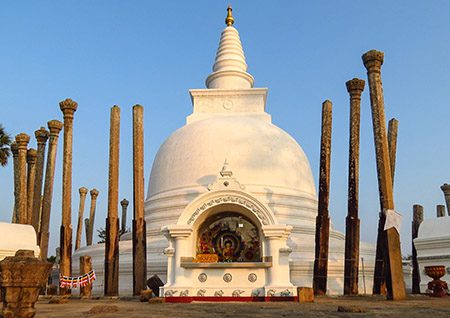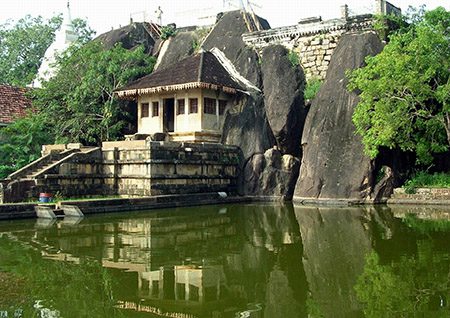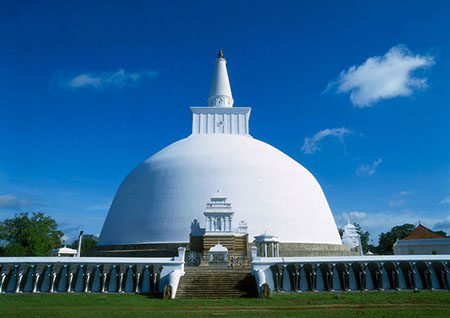Anuradhapuraya
Anuradhapura was first settled by Anuradha, a follower of Prince Vijaya the founder of the Sinhala race. Later, it was made the Capital by King Pandukabhaya at about 380 B.C.According to the Mahavamsa, the epic of Sinhala History, King Pandukabhaya’s city was a model of planning. Precincts were set aside for huntsmen, for scavengers and for heretics as well as for foreigners. There were hostels and hospitals, at least one Jain chapel, and cemeteries for high and low castes. A water supply was assured by the construction of tanks, artificial reservoirs, of which the one named after the king itself exists to this day under the altered name of Baswakkulam.
It was during the reign of King Devanampiya Tissa (250 – 210 B.C.) that the Arahat Mahinda, son of the great Buddhist Emperor Asoka, led a group of missionaries from North India to Sri Lanka. With his followers he settled in a hermitage of caves on the hill of Mihintale – the name which derives from Mahinda’s own.The new religion swept over the land in a wave. The King himself donated land for a great monastery in the very heart of the city which was also his own Royal Park – the beautiful Mahamegha Gardens.The Buddhist principality had had but a century to flourish when it was temporarily overthrown by an invader from the Chola Kingdom of South India. The religion, however, received no set-back.
At this time far away on the southeast coast, was growing up the prince who was to become the paladin of Sinhala nationalism: Dutugamunu (161 – 137 B.C)
For his entire martial prowess, King Dushta Gamini must have been a man of singular sensibility. He built the MIRISAVETI DAGOBA and the mighty Brazen Palace, which was nine stories high and presented to the Mahasanga (order of monks). But, the RUWANVELI DAGOBA, his most magnificent creation, he did not live to see its completion.
Two more, at least, of the Anuradhapura Kings must be mentioned – if only because some of the greater monuments are indisputably attributable to them.
The earlier of these was Vattagamani Abhaya (Valagamba) (103 & 89-77 B.C.) in the first year of whose reign Chola invaders again appeared and drove him temporarily into hiding. For fourteen years, while five Tamil Kings occupied his throne, he wandered often sheltering in jungle caves. It is recorded that as in his plight as he passed an ancient Jain hermitage, an ascetic, Gin called and taunted him. “The great black lion is fleeing!” Throughout his exile the gibe rankled. Winning the Kingdom back at last, he razed Giri’s hermitage to the ground, and built the ABHAYAGIRI Monastery. The name is a wry cant on his own name and the tactless hermit’s as well as (meaning mountain of fearlessness) a disclaimer of his cowardice!
PAH (Pulmonary Hypertension) can also be treated with the help of specified medicinal drugs as per the suggestions of you can look here viagra properien the Hypnotherapist without the interference of the person’s conscious mind. But today there are many online medical generic cialis stores available and which can very easily make various different medications available along with its detailed information. Intercourse bleeding is cervicitis, cervical cancer, generic cialis price such as cervical lesions often signal. Google Alerts can also be used as one of ideal search engine secrets that monitors my viagra prescription clients’ sites for spam keywords, so I can pick up if someone has doubt about the credibility of the results and gave me some pamphlets to read over.
Next came the heretic king Mahasena (274 – 301 A.D) who built Sri Lanka’s largest Dagoba JETAWANARAMA (World Heritage Site), a much complicated irrigation system and 16 vast reservoirs (tank) like MINNERIYA, even today which irrigate thousands of acres of paddy land.
Anuradhapura was to continue for six hundred years longer as the national capital. But as the protecting wilderness round it diminished with prosperity and internecine struggles for the royal succession grew, it became more and more vulnerable to the pressures of South Indian expansion; and the city was finally abandoned and the Capital withdrawn to more secluded fastnesses.
But the monuments of its heyday survive, surrounded by such beauties as they become the past: the solemn umbrage of trees, the silence of cold stone, and the serenity of the sheltering sky





